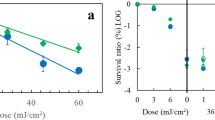Abstract
STUDY of the abiogenic formation of biologically important compounds under primitive Earth conditions has led us to suggest the probable path of synthesis of porphine-like . This hypothesis proposes that porphines and porphine-like substances were formed spontaneously by condensation of pyrroles and aldehydes. A similar scheme has also been suggested by Krasnovskii2. The aldehyde, one of the required starting materials for this spontaneous synthesis, has been found as a product of the exposure of Urey's atmosphere to electrical . The other primitive reactant, pyrrole, was assumed to be present, since acetylene and ammonia under primitive Earth conditions would form pyrroles by the action of electrical discharges4.
This is a preview of subscription content, access via your institution
Access options
Subscribe to this journal
Receive 51 print issues and online access
$199.00 per year
only $3.90 per issue
Buy this article
- Purchase on Springer Link
- Instant access to full article PDF
Prices may be subject to local taxes which are calculated during checkout
Similar content being viewed by others
References
(a) Szutka, A., Hazel, J. F., and McNabb, W. M., Radiation Res., 10, 597 (1958); (b) Szutka, A., Nature, 202, 1231 (1964); (c) Szutka, A., in The Origins of Prebiological Systems and of Their Molecular Matrices, Fox, S. W., edit., 243 (Academic Press, New York, N.Y., 1965). (d) Szutka, A., and Radzilowski, R. H., Z. Naturforsch., 20b, 624 (1965).
Krasnovskii, A. A., and Umrikhina, A. V., Dokl. Akad. Nauk S.S.S.R., 155, 691 (1964).
(a) Miller, S. L., J. Amer. Chem. Soc., 77, 2351 (1955); (b) Miller, S. L., and Urey, H. C., Science, 130, 245 (1959).
Chichibabin, A. E., J. Russ. Phys.-Chem. Soc. (Chem.), 47 (Otd. 1), 703 (1915).
(a) Gaffron, H., in Rhythmic and Synthetic Processes of Growth, edit. by Rudnick, D., 127 (Princeton University Press, Princeton, N. J., 1957). (b) Perspectives Biol. Med., 3, 163 (1960); (c) in Horizons in Biochemistry, edit. by Kasha, M., and Pullman, B., 59 (Academic Press, New York, N.Y., 1962); (d) in The Origins of Prebiological Systems and of Their Molecular Matrices, edit. by Fox, S. W., 437 (Academic Press, New York, N.Y., 1965).
Shemin, D., Proc. Third Intern. Cong. Biochem., 197 (1956).
Gibson, K. D., Neuberger, A., and Scott, J. J., Biochem. J., 61, 618 (1955).
Bogorad, L., in Biogenesis of Natural Compounds, edit. by Bernfeld, P., 183 (Macmillan Co., New York, N.Y., 1963).
Choughuley, A. S. U. (personal communication).
Mauzerall, D., and Granick, S., J. Biol. Chem., 219, 435 (1956).
Shuster, L., Biochem. J., 64, 101 (1956).
Granick, S., and Mauzerall, D., in Metabolic Pathways, edit. by Greenberg, D. M., 2, 525 (Academic Press, New York, N.Y., 1961).
Author information
Authors and Affiliations
Rights and permissions
About this article
Cite this article
SZUTKA, A. Formation of Pyrrolic Compounds by Ultra-violet Irradiation of δ-Aminolevulinic Acid. Nature 212, 401–402 (1966). https://doi.org/10.1038/212401a0
Issue Date:
DOI: https://doi.org/10.1038/212401a0
This article is cited by
-
The Porphobilinogen Conundrum in Prebiotic Routes to Tetrapyrrole Macrocycles
Origins of Life and Evolution of Biospheres (2017)
-
Which Way to Life?
Origins of Life and Evolution of Biospheres (2010)
-
Ribonucleotide reduction and the possible role of cobalamin in evolution
Journal of Molecular Evolution (1977)
-
Chemical evolution, recent syntheses of bioorganic molecules
Space Life Sciences (1973)
-
Current status of chemical studies on the origin of life
Space Life Sciences (1968)
Comments
By submitting a comment you agree to abide by our Terms and Community Guidelines. If you find something abusive or that does not comply with our terms or guidelines please flag it as inappropriate.



